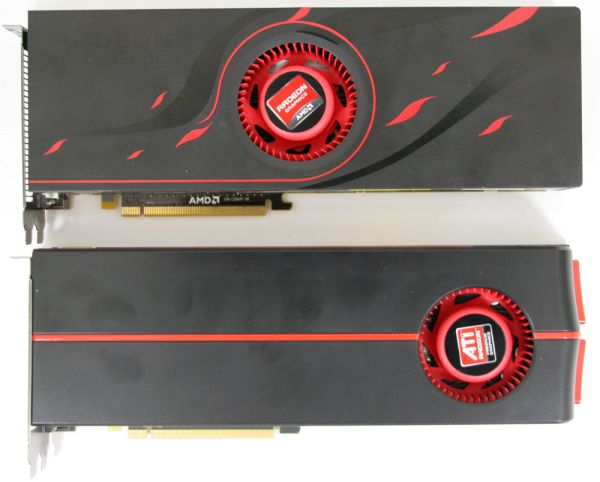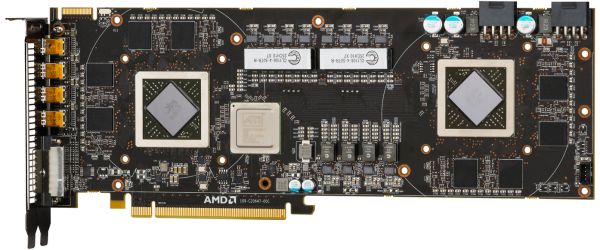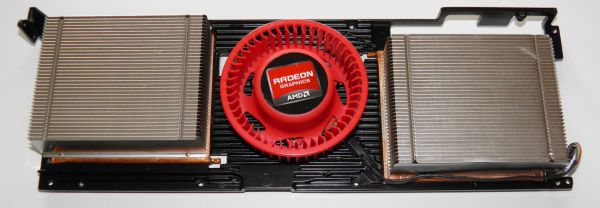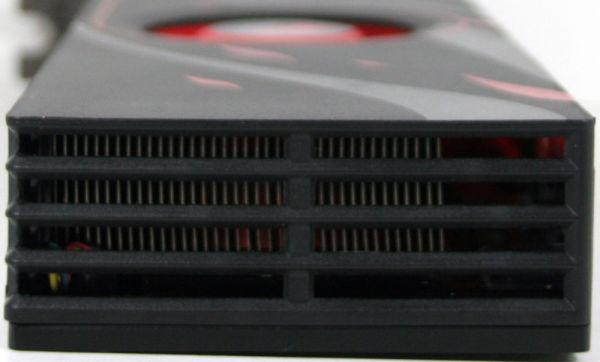AMD's Radeon HD 6990: The New Single Card King
by Ryan Smith on March 8, 2011 12:01 AM EST- Posted in
- AMD
- Radeon HD 6990
- GPUs
Meet The 6990
If you recall our coverage on the 5970, we found a few areas where AMD was lacking. The cooling on the 5970 was sufficient to run the GPUs even at 5870 clocks and voltages, however the cooling on the VRMs was lacking, leading to real world programs trigging the VRM thermal protection mechanism; and while this was within safety guidelines, it’s not a comfortable place to be for long term operation. This ultimately led to us writing off the 5970OC as a 100% reliable product, sticking to recommending the 5970 solely at stock speeds.
The design of the 6990 in turn reads very much like a response to our findings in true engineering fashion. Furthermore for the 6990 AMD not only had to take a look at the 5970’s weaknesses, but also how to handle an even greater power load. The result is that the 6990 is distinctly different from the 5970 before it.
Compared to the 5970, the 6990 is ever so slightly shorter, thanks in large part to the fact than the 6000 series casing is more squared off compared to the 5000 series’ tapered design. As a result it comes in at 11.5” for the PCB (the same as the 5970), and with casing a full 12” long compared to the 5970’s 12.16”. This means that the 6990 has effectively the same space requirements as the 5970, cooling notwithstanding.
Meanwhile it’s the fan however that is going to catch the most attention and this is where we’re going to dovetail in to cooling. The 5970’s traditional blower had its strengths and weaknesses, the strengths being that blowers are relatively forgiving about a case’s ability to exhaust hot air, and the weaknesses being that the GPU (and VRMs) closest to the fan received better cooling than the farther GPU. The VRMs proved to be particularly problematic, as they could overheat well before the GPUs did and AMD does not spin up their fans based on VRM temperatures.
Correcting for this and at the same time allowing for even greater heat dissipation, the rear blower design is out. Its replacement is a design that we’ve seen in 3rd party cards before such as the Asus ARES 5870X2, but not in a reference design: a center-mounted fan/blower with a GPU to each side. The difference is critical and indeed cannot be understated: a rear blower channels most hot air outside of the case, while a center-mounted blower effectively splits the card in two, with one GPU + supporting chips being exhausted outside of the case, and the 2nd GPU + supporting chips being exhausted inside the case. The design is still enclosed, so everything goes out either the front or back of the card while fresh air is pulled in the center.
With the replacement of the blower, so has gone the heatsink. The 5970’s single large vapor chamber + heatsink design has been replaced in favor of a segmented heatsink, further driving home the concept that the 6990 is closer to 2 video cards sharing 1PCB than it is 2 GPUs on one card. Each heatsink in turn is connected to the GPU via its own vapor chamber, resulting in the GPUs being fully isolated from each other as far as cooling is concerned.
Even the thermal paste connecting the GPUs to the vapor chambers has been changed for the 6990 – AMD has replaced traditional paste with a phase change material. Phase change materials – pastes/pads of material that melt and solidify based on temperature are nothing new, however they’re still exotic; material similar to what AMD is using is not readily available as paste is. AMD even went so far as to suggest that reviewers not directly disassemble their 6990s as it would require a new application of phase change paste in order to achieve the same efficiency as the original material. The net result of all of this by AMD’s numbers is that the phase change material is 8% better than the regular paste they’ve been using.
Rounding out our focus on cooling is the VRMs, which have been relocated in order to correct for the 5970’s limited VRM cooling capabilities. The VRMs and controllers are now at the center of the board – now they’re cooled before the GPUs or RAM modules are. The profoundness of this is twofold: not only is it an improvement on the 5970, but with the 6990’s higher power consumption VRM cooling is even more important. As with the 6970, voltage regulation is supplied by Volterra MOSFETs and controllers.
All told, while the 5970 was designed to handle and dissipate 400W of heat, the 6990 is officially designed for 450W. In practice, at its limits in our test rig this is closer to 500W. To handle and dissipate that much heat in roughly 72in3 of space is nothing short of amazing.


















130 Comments
View All Comments
Figaro56 - Tuesday, March 8, 2011 - link
Just be prepared to upgrade your GPU every year. If you think they are going to stop leap frogging performance you are not being realistic.san1s - Tuesday, March 8, 2011 - link
"AMD even went so far as to suggest that reviewers not directly disassemble their 6990"The next picture: The card disassembled
haha
Ryan Smith - Tuesday, March 8, 2011 - link
To AMD's credit, they were good sports offered to take any pictures we needed. So all of those disassembled shots came from them. They were really adamant about it being a bad idea to take these things apart if you intended to use them in the future.strikeback03 - Tuesday, March 8, 2011 - link
I was looking for a comment on whether you did all your testing before disassembling or whether you got some of their super paste to reassemble.7Enigma - Tuesday, March 8, 2011 - link
My problem with the shot is the poor application of thermal paste from the picture. In a card of this magnitude having a perfect coating of thermal compound is critical. And knowing marketing if that is the shot they SHOW, how good do you really think the application is on one purchased in retail channels?iwod - Tuesday, March 8, 2011 - link
I haven't been following CrossFire / SLI or these Single Card Dual GPU closely. ( Which to me are the same as two card anyway )Do they still need drivers to have a specific profile of the game to take advantage? I.e an Unknown Game to the Drivers will gain 0 benefits from the 2nd GPU?
If that is so, then they are not even worth a look.
Figaro56 - Tuesday, March 8, 2011 - link
Most of the big games support SLI and CrossfireX today. For example, I play Battlefield BC2 myself and using 2 video cards blows the doors of a single card and is well worth the investment, especially if you have a 2560x1600 resolution monitor like I do. For 2 ATI cards in Crossfire you install a separate crossfire profiles pack in addition to the catalyst drivers. The profiles pack supports all the game crossfire optimization. The AI mode in the catalyst drivers exploits the game profile pack setting for crossfire so you want that enabled.A dual GPU HD 6990 is essentially crossfire on a single card, but for some reason it doesn't perform as well as dual single GPU cards in crossfire. Go figure.
If you play old games that don't support SLI or Crossfire then YES there is 0 gain. If you have not tried any of the new games what are you waiting for? It doesn't suck you know?!
cactusdog - Tuesday, March 8, 2011 - link
I agree, unless you have eyefinity and one slot, paying a premium for heat and noise doesnt make sense. For most people with 1 screen a 6970 or 580 is more than enough.Samus - Tuesday, March 8, 2011 - link
i'd be shocked if they sold even one of these without it being returned at some point. the noise levels are astonishing. at full blast the thing doesn't even meet federal vehicle emissions noise regulations without being classified as a motorcycle!MadAd - Tuesday, March 8, 2011 - link
8%? where do we buy tubes of this phase change material? do they sell it like arctic silver?